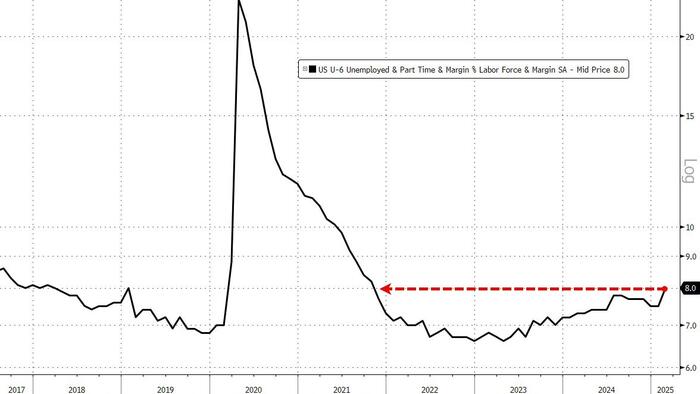


Authored by Peter Tchir via AcademySecurities.com,
The NFP data is usually quite a big deal for the market. I’m not horribly excited about this report for the following reasons:
I’m not convinced they tell us much going forward, but we will do our best to pull out the most interesting nuggets from this data. But first, a reminder that the S&P 500 has dropped almost 7% since February 19th (the Nasdaq 100 almost 10%).
The only data point that jumps out at me is the Underemployment Rate.
Usually something I glance at, but it jumped from 7.5% to 8% even as the labor participation rate fell. That is the highest it has been since October 2021 (when we were still in the aftermath of COVID). Pre COVID, the data doesn’t look as bad, though you need to go back to 2017 to find worse prints (8.1% was the high print in 2018 and 2019). While anything based on the Household part of the survey has a margin of error that can make it almost as useful as a random number, this still strikes me as concerning. I expect the JOLTs Quit rate next week to confirm that the labor market was already shaky BEFORE the start of the tariff wars and shift in behavior towards the EU.
I’m normally all excited to dig through the data, and look for outliers, but I just don’t care enough – that is how irrelevant I think this data is (asides from the fact that on a cursory glance it probably lets the Fed cut as soon as the May meeting – which is my base case).
Now is as good as time as any to read last weekend’s T-Report Skate to Where the Puck is Going, as it leads nicely into the following takes.
The tariff policy continues to pose a risk for the economy. One that both the President and Treasury Secretary recognize. It is far too early to tell if their policies will result in the desired outcome or not, but expect more downside to equities in the near term, unless some major positive headlines develop.
On Europe, Russia, Ukraine and NATO, there are only two observations I feel obligated to make, because I think both are important to the markets.
On the market front the AI story is evolving rapidly as well:
I’d care less about the previous section except so much of the market is “passive” and outflows from any mega cap impact the indices, and in turn trading behavior, potentially adding to the downside risk. (I use quotations because I don’t think “passive” is really “passive” any longer, at least not in the sense that it was 2 decades ago).
Despite the large move to the downside in equities, there is far more evidence pointing to dip buying than capitulation.
Look for the rest of the world to outperform the U.S.
Look for equal weight to outperform market weight indices.
The Crypto Reserve.
The good news is that the executive order from last night looks quite tame in terms of buying crypto. Crypto already held, largely through seizures will be allowed to be in the reserve. Budget neutral purchases can be made. It really seems to depend on how aggressive the Crypto Czar wants to be with “budget neutral”. If the summit later today comes out sounding like an “all in” for crypto – I’d sell treasuries quickly. It has a banana republic sort of feel.
All of the above, I guess I could have started with Are We Exchanging Trade for Capital Flows? That was one of many topics that came up on Bloomberg TV Wednesday morning (we are in the first segment, so just hit play).
Is the focus on reducing trade deficits working to reduce capital surpluses?
To the extent that is occurring, which seems somewhat logical, and is backed by academia, risk assets could be in for a bumpier ride than previously thought.
Finally, watch credit. If credit spreads widen (which I think they will) then that will feed into further risk-off fears for risk assets.
I wish I had a lot more good things to say, but I don’t, other than it is almost time to be thinking about March Madness! Of the basketball variety, not markets!
